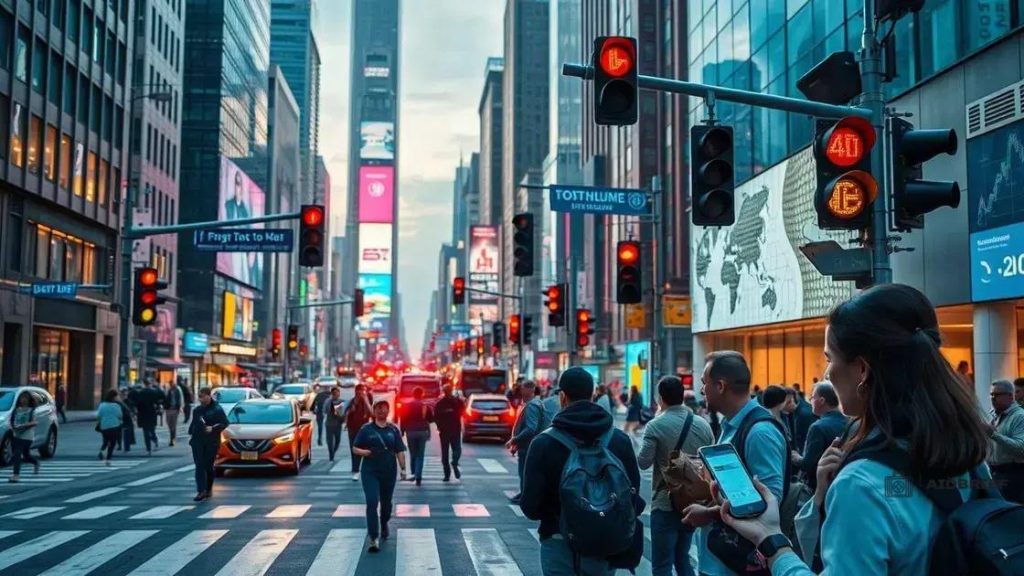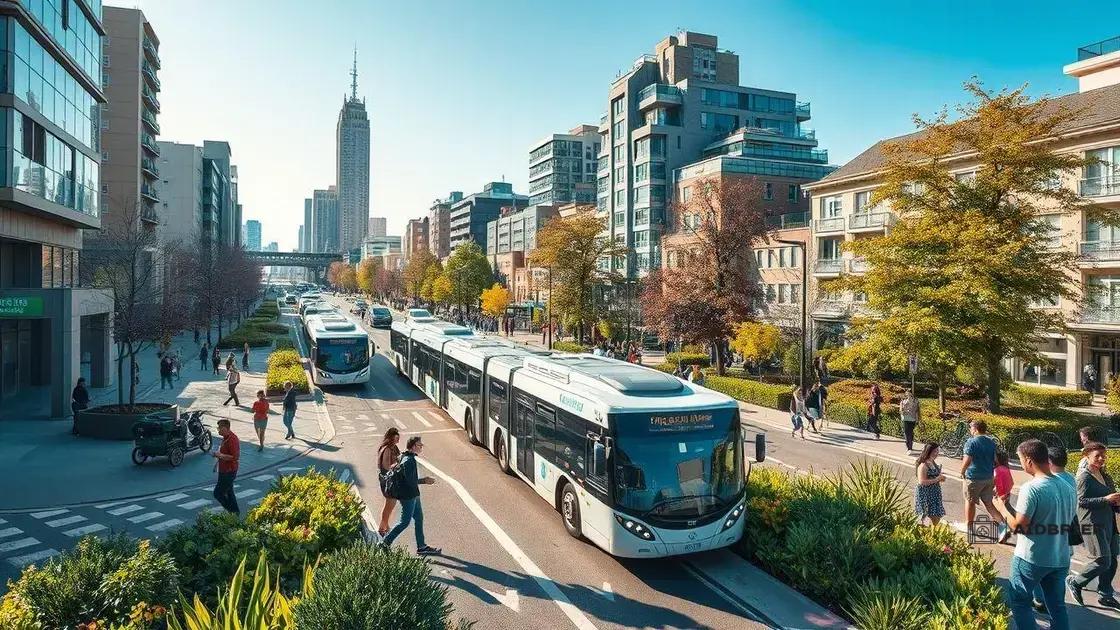Smart cities: how technology is reshaping urban life

Smart cities utilize advanced technologies, such as IoT and AI, to enhance urban efficiency, improve public services, and promote sustainability while addressing challenges like funding, data privacy, and community engagement.
Smart cities are changing the way we live, utilizing technology to enhance urban environments. Have you ever considered how innovations like smart traffic lights or app-based public transport affect your daily commute? Let’s delve into this exciting transformation.
Defining smart cities and their significance
Defining smart cities is crucial to understanding their role in modern urban life. A smart city is an urban area that uses digital technology to enhance performance and improve the quality of life for its residents. By integrating information and communication technology (ICT), smart cities can manage assets and resources efficiently.
Key Features of Smart Cities
Smart cities utilize various elements that contribute to their effectiveness. These features include:
- Data-driven decision-making: Collecting and analyzing data allows city planners to make informed choices for urban development.
- Sustainable energy solutions: Smart grids and renewable energy sources help reduce carbon footprints.
- Smart transportation: Implementing connected transport systems improves traffic flow and reduces congestion.
- Enhanced public services: Smart cities provide better healthcare, education, and security through technology integration.
Each of these elements plays a role in fostering a more efficient and livable urban environment. For instance, the implementation of smart transportation systems not only eases traffic but also contributes to a cleaner environment by reducing emissions.
Another critical aspect involves citizen engagement. In a smart city, residents can easily access city services and provide feedback through digital platforms. This participation encourages a sense of community and helps authorities gauge the needs of the population. Furthermore, as technology continues to evolve, smart cities remain adaptable and capable of integrating new solutions to address emerging challenges.
In summary, smart cities are more than just technological advancements; they represent a holistic approach to urban living that prioritizes sustainability, efficiency, and community well-being.
Key technologies driving smart cities
Several key technologies are driving the growth of smart cities. These technologies work together to make urban areas more efficient, livable, and sustainable. Understanding these technologies is essential for grasping how smart cities operate.
Internet of Things (IoT)
The Internet of Things plays a crucial role in connecting devices and systems within a city. Sensors placed throughout urban environments collect data on various parameters, such as air quality, traffic patterns, and energy consumption. This real-time data allows city officials to make informed decisions.
Big Data and Analytics
With the vast amount of data collected in smart cities, big data analytics becomes essential. By analyzing this information, cities can identify patterns and trends to improve services. For example, analyzing traffic data can help in optimizing traffic light timings to ease congestion.
- Enhanced public safety: Analytics help predict and manage crime by monitoring activities.
- Efficient resource management: Cities can optimize water and energy usage through data insights.
- Improved transportation: Data helps in developing better public transit routes based on user needs.
Another important technology is cloud computing, which provides the necessary infrastructure for data storage and processing. This technology enables cities to maintain their data securely while ensuring that various services are available on-demand.
Additionally, smart mobility solutions, such as electric and autonomous vehicles, are transforming transportation in urban settings. These vehicles not only reduce emissions but also enhance the overall efficiency of transit systems, making them more convenient for residents.
By integrating these technologies, smart cities can create a connected environment that enhances the quality of life for all residents while addressing pressing urban challenges.
The impact of smart cities on everyday life

The rise of smart cities is transforming everyday life for residents in numerous ways. These urban environments leverage technology to enhance the quality of living and provide valuable services that contribute to overall well-being.
Improved Public Services
One significant impact is the improvement in public services. By using data and technology, smart cities can streamline operations, making services more efficient and accessible. For example, waste management systems can monitor the levels of garbage in bins, optimizing collection routes and reducing costs.
Transportation Efficiency
Transportation is also vastly improved in smart cities. Intelligent transport systems help manage traffic flow, reducing congestion and travel times. With real-time updates available through mobile apps, residents can check transit schedules, traffic conditions, and alternative routes instantly.
- Ease of mobility: Automated transit solutions like electric buses and rideshares enhance public transportation.
- Reduced travel times: Smart traffic lights adjust based on traffic conditions, allowing smoother vehicle movement.
- Safer streets: Surveillance and monitoring systems increase safety for pedestrians and cyclists.
Furthermore, smart cities promote environmental sustainability. Green technologies, like solar panels and energy-efficient buildings, not only reduce energy consumption but also enhance air quality. Residents can contribute to sustainability efforts by engaging with smart applications that allow them to monitor their energy use.
Community engagement is another cornerstone of smart cities. Many city services are now available through digital platforms, allowing residents to report issues, access resources, and participate in decision-making. This active participation fosters a sense of community and transparency in governance.
Overall, the impact of smart cities is profound, reshaping daily routines and enhancing the living experience by making cities more efficient, responsive, and environmentally friendly.
Challenges faced in developing smart cities
Developing smart cities presents several challenges that urban planners and local governments must address. Despite the many benefits of smart technologies, various obstacles can hinder progress.
Funding and Investment
One major challenge is securing sufficient funding. Smart city projects often require significant investment in technology and infrastructure. Local governments may struggle to allocate funds or attract private investment. Without adequate financial resources, planned initiatives may falter or be delayed.
Data Privacy and Security
Another critical issue relates to data privacy and security. As cities collect vast amounts of data from residents through sensors and devices, concerns about how this data is used and stored become paramount. Ensuring robust cybersecurity measures is essential to protect sensitive information from breaches.
- Protecting personal data: Safeguarding residents’ information is vital to maintain trust.
- Regulatory compliance: Adhering to data protection laws can complicate data management.
- Public awareness: Educating citizens about data use is critical for transparency.
Moreover, integrating new technologies into existing urban frameworks poses technical challenges. Cities often have outdated infrastructure that may not support advanced solutions. Upgrading systems while minimizing disruption to daily life requires careful planning and execution.
Also, there can be resistance from residents who are wary of changes or skeptical of new technologies. Effective community engagement is necessary to address concerns and gain public support. Ensuring that all voices are heard fosters inclusivity in smart city development.
Achieving successful smart city initiatives demands collaboration among stakeholders, including government entities, private companies, and the community. Only by facing these challenges head-on can cities fully realize the potential of smart technologies and enhance urban living.
Future trends in smart city development
The future of smart city development is bright, with advancements in technology poised to reshape urban living. As cities continue to evolve, several trends are emerging that promise to enhance sustainability, connectivity, and efficiency.
Sustainable Innovations
One of the key trends is the increased focus on sustainability. Future smart cities will prioritize green technologies, such as renewable energy sources and energy-efficient infrastructures. For example, more buildings will feature solar panels, and cities will utilize wind energy to power public amenities.
Enhanced Connectivity
As Internet of Things (IoT) devices proliferate, connectivity within smart cities will deepen. Cities will deploy vast networks of sensors to collect real-time data on various aspects, from traffic to air quality. This data will be utilized to optimize city functions and improve resident experiences.
- Smart mobility: More cities will adopt autonomous vehicles and electric public transport solutions, making travel more efficient.
- Personalized services: Connected platforms will tailor city services based on individual resident preferences and needs.
- Greater public engagement: Interactive apps will encourage citizens to give feedback and participate in local governance.
Additionally, urban design is shifting toward creating more walkable and bike-friendly spaces. Smart city planners will focus on reducing the dependency on cars, promoting healthier lifestyles and improving air quality.
The integration of artificial intelligence (AI) in city management is also on the rise. AI can analyze data trends quickly, helping city officials make better, data-driven decisions. It can improve resource allocation in key areas such as energy consumption and waste management.
Furthermore, cybersecurity will become a core component of smart city frameworks. As cities rely more on digital infrastructure, ensuring the protection of sensitive data from cyber threats will be a top priority.
Overall, the future of smart city development will be characterized by innovation, sustainability, and a strong focus on community engagement and safety.
FAQ – Frequently Asked Questions about Smart Cities
What are smart cities?
Smart cities use digital technology to enhance performance and improve the quality of life for residents by integrating various smart solutions.
How do smart cities improve public services?
Smart cities streamline operations using data, allowing for more efficient delivery of services like waste management, transportation, and healthcare.
What role does data play in smart cities?
Data collected from various sources helps city planners make informed decisions, optimize resources, and enhance residents’ experiences.
What are some challenges faced by smart cities?
Challenges include securing funding, ensuring data privacy, integrating new technology with old infrastructure, and engaging the community.





